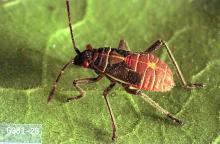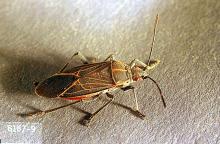Boisea rubrolineata
Pest description and damage The boxelder bug is often a nuisance pest around and in homes where boxelder is commonly grown. The adult boxelder bug is a red, flat, and elongated bug about 0.5 inch in length. The front wings and thorax are dark gray to black with thin bright red markings. The eggs are red. The bright red nymphs look like the adult but without wings and smaller. These bugs feed on the leaves, flowers, and seedpods of the boxelder tree (Acer negundo), and on other maple species and ash. They may also feed on the fruits of apple, cherry, peach, pear, and plum trees. Large numbers of the bug usually occur only on female boxelder trees. They do little damage to ornamentals, though they can cause some leaf distortion.
Biology and life history In spring, the overwintered females lay eggs in the cracks and crevices of the boxelder tree's bark, and the nymphs hatch in a few days. The nymphs feed, grow and develop into adults during the summer. They then mate and lay eggs that hatch into the second-generation nymphs. Most of the nymphs of the second generation grow to full size by August and September. In autumn, the adults seek overwintering places in dry, sheltered hollow tree trunks, under rocks, boards, and other debris, in cracks and crevices in walls, in door and window casings, around building foundations and inside houses. They become a nuisance outdoors in patios or indoors when they invade homes in significant numbers.
Management-cultural control
Removal of seed pods of boxelder trees from the ground around the trees may help. Replacement of maple and boxelder trees with other tree species that do not produce as much seed will reduce populations. Where boxelder bugs become a nuisance as congregations on house walls, patios, decks, or storage areas, use a vacuum to remove them.
Management-chemical control
See Table 1 in:




